 BBC News
BBC NewsBorrowing was £17.4bn last month, the second highest October figure since monthly records began in 1993.
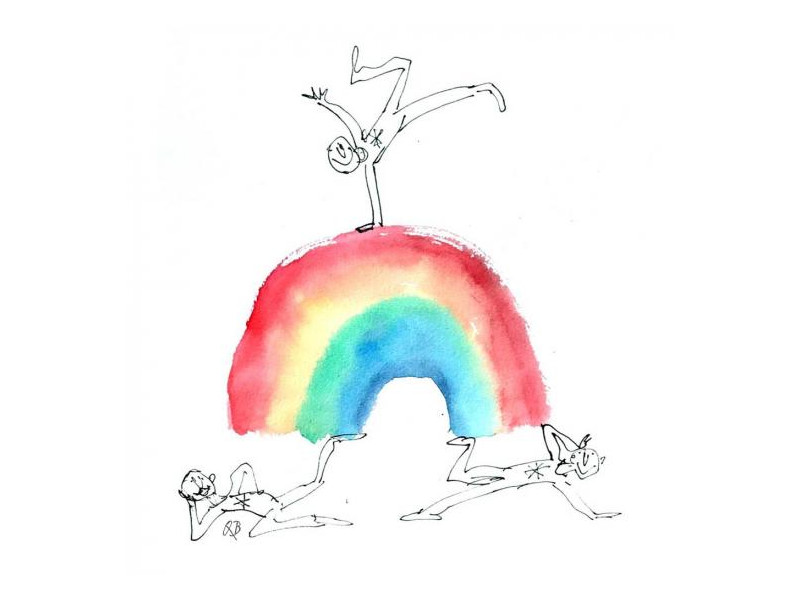
ROBERT GOLDING LOOKS BACK ON A TOUGH YEAR FOR THE ARTS AND HERITAGE SECTOR BUT DISCOVERS HOPE AHEAD
Anthony Gormley stands before a sea of small clay figurines at the First Site gallery in Colchester and poses for photographs. ‘I’m very, very thrilled,’ he says. ‘It’s never been more relevant than now.’ He is referring to his thought-provoking sculpture Field for the British Isles: a sea of faces, all open-mouthed looking eerily back at the viewer. First produced in 1993, it won him the Turner Prize in 1994.
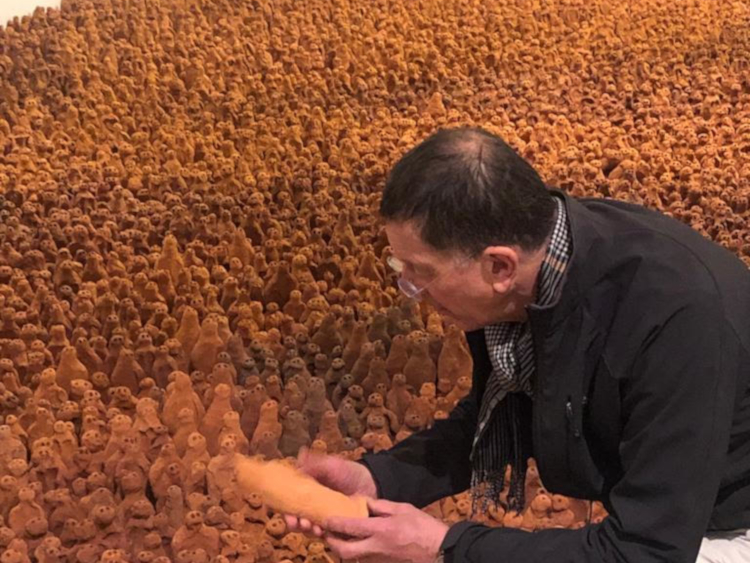
Gormley never looked back, and the work too has shifted, as good art does, with the times. ‘I’m proud to see it here,’ he says. ‘Colchester has a long, proud history of immigration.’ Then pointing to the inspired installation, where the faces amass until they reach a corner and then disappear off unseen, Gormley exhibits a boyish thrill: ‘It’s never been shown ‘on the angle’ as it were, where the first bit of orthogonal architecture promises to dispense with orthogonality.’
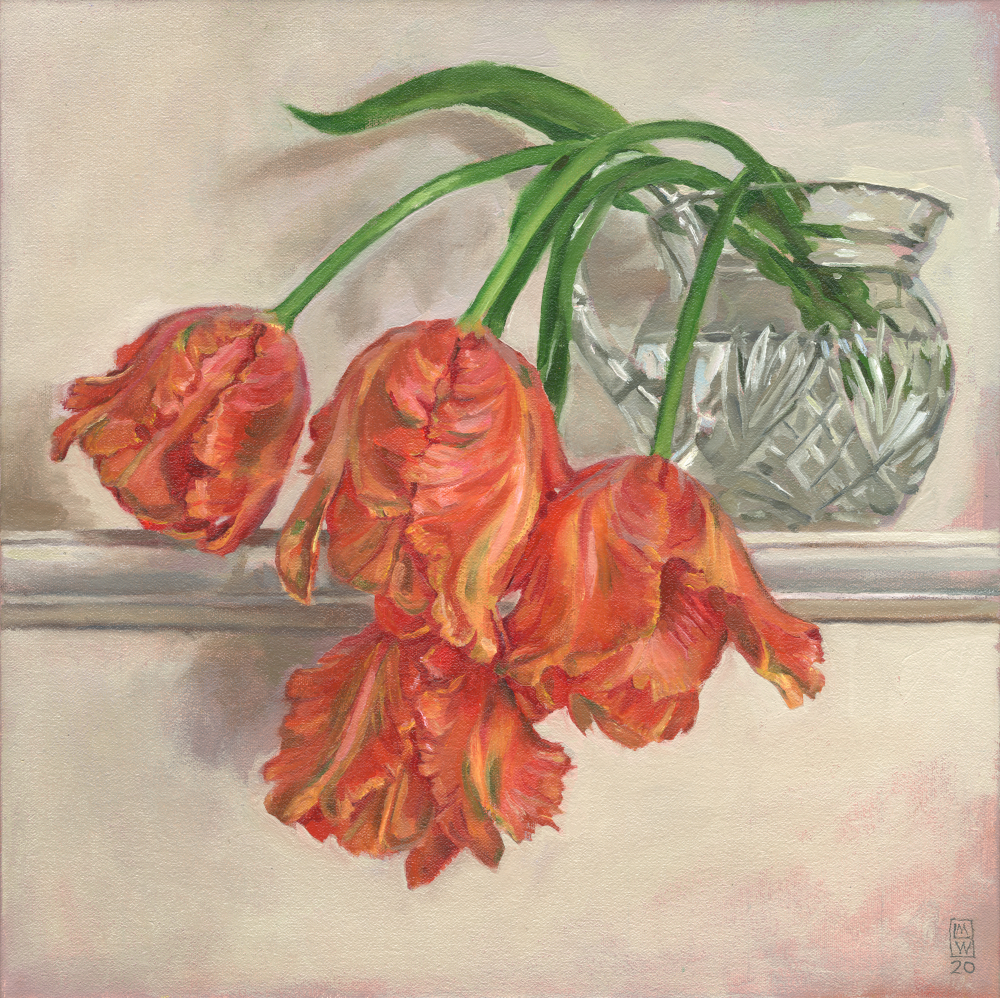
Perfect Tulips Escape Fictional Jug by Lorna May Wadsworth, 2020
All of which would ordinarily be perfectly normal – a famous artist using the word ‘orthogonality’ while journalists and gallery directors nod sagely, enjoying their proximity to greatness, and concealing their bafflement. In the ordinary scheme of things, one might also relate all that the sculptor went on to say about Brexit; how generous he was with his time; and how marvellous it is when an artist plainly enjoys elaborating on their work.
Except that this is not the ordinary scheme of things, as Gormley was speaking on the eve of the coronavirus. The world, without anyone being aware of it, was primed for change.
The Ides of March
2020 was set to be another year of treats: Titian at the National Gallery, Van Eyck at MSK Gent, Cranach at Compton Verney. As the virus proliferated, anxious gallery directors had suddenly to cope with dramatically suspended footfall. They examined not just their balance sheets, but in many cases their raison d’être. Curators turned themselves overnight into online TV presenters, as galleries pivoted to virtual exhibitions, with mixed results.
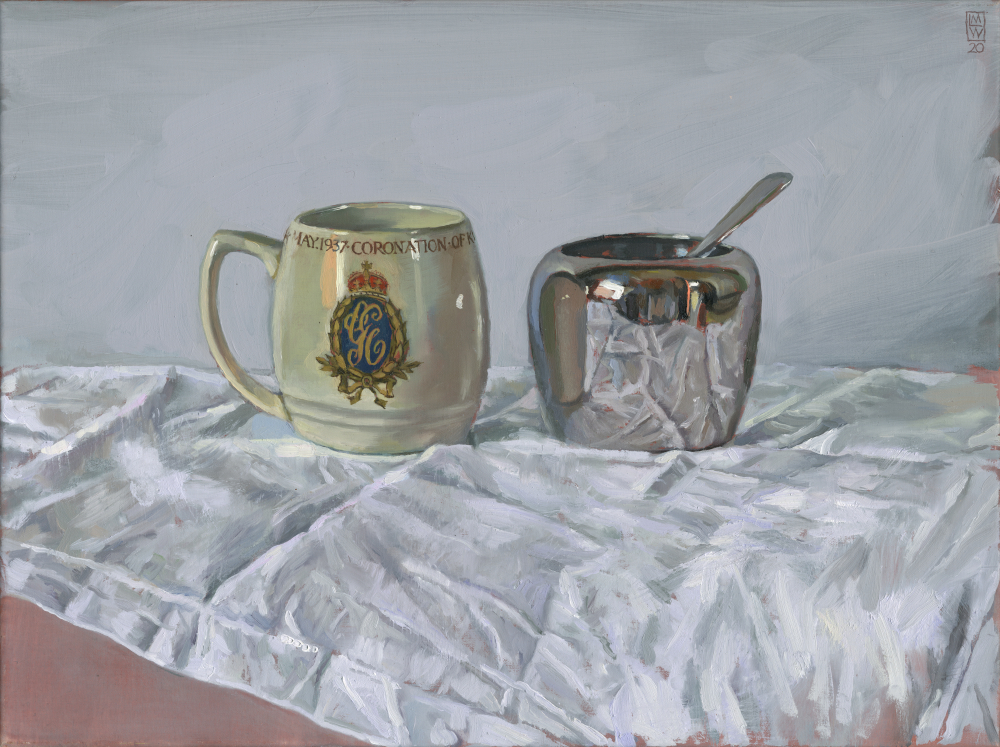
Still Life by Lorna May Wadsworth, 2020
As with the wider economic story of coronavirus, there was a terrible randomness about 2020: the arbitrariness of the virus ruled all. Survival depended on one’s cash flow going into the crisis, yes, but also on the layout of a site. Did your gallery have monetisable outside space like Hampton Court? If so, you could at least reopen your gardens. But what if your gallery was urban, like, say, the Handel House off New Bond Street, a space where social distancing was impossible? For such sites, a long road lay ahead.
Maev Kennedy, the former arts editor at The Guardian and BBC Radio 4 presenter, had been due to travel to Ghent for the Van Eyck exhibition, but had to cancel. Naturally ebullient, with a warm Irish voice, she seems an unlikely messenger of pessimism, but pessimistic she undoubtedly is. She tells me that the urban sites face ‘a gigantic problem’. The example she gives is Turner’s House, known as Sandycombe Lodge in Twickenham. ‘It’s the only surviving property Turner designed himself. It has a handful of small rooms and one winding staircase. You might be talking admitting five visitors at a time, so how do you make the numbers stack up?’ she asks.
Kennedy is also worried for the National Trust, which announced 1200 job losses in late July. ‘It has a huge advantage of the enormous and incredibly loyal friends base, but the problem will be a demographic one. The volunteer base are overwhelmingly over 60s and that might be being polite.’
Kennedy speaks with great authority, and her pessimism is especially convincing since it plainly comes from a place of longstanding love. Even in September, as many galleries and museums embark on reopening strategies, her voice remains with me, urging caution.
The Pivot to Digital
Not every gallery we spoke to was caught off guard by the pandemic. Compton Verney’s director Julie Finch was well-prepared for the virus thanks to a journey she took to the Far East at the start of the year.

One of Quentin Blake’s ‘portable rainbows
‘I travelled in February through Singapore and so I saw it coming,’ she tells us. ‘As soon as I got back, I set up a Covid-19 team. I was insisting at the end of February that people not sit close together in meetings and everyone thought I was bonkers.’ Finch now realises she was fortunate to be a step ahead: ‘We prepared for a staged closure and had a social distancing policy before lockdown. It was only for a week but people carried on visiting and the feedback was that everyone felt safe. But we ended up locking down the house, and closing the grounds on 20th March.’
So although Finch soon realised that she’d ‘lost a year of income’ – the shortfall stemmed particularly from reorganised weddings – she also realised she had to seek ‘the good will to rebook.’ Finch had also proved to herself and others that she could make the Compton Verney experience viable going forwards.
The great anxiety for the heritage sector is that the cost of opening can sometimes exceed the cost of staying closed. Finch explains: ‘We generate about £1.6 million a year through commercial activity but just to house the collection at Compton Verney costs £300,000 a year. You’re talking security, air handling units, management processes, conservation.’ A museum cannot just sit tight in a way some businesses can.
Galleries were therefore thrown back on their digital smarts – an area which many institutions subsequently realised they’d not been paying sufficient attention to prior to the pandemic. ‘We invented a digital strategy overnight and went live with the Cranach exhibition,’ Finch explains. But this was no silver bullet: ‘The question is: “How can you monetise digital and reach a wider audience going forwards?” In its first week we had 22,000 views and we would never have received that normally. But we had no pay wall.’
Ay, there’s the rub. Finch notes that the virus creates an opportunity to ‘nurture the virtual community,’ but there does seem a lack of detail as to how this will ever make up the shortfalls in revenue.
Maev Kennedy is unconvinced about the proliferation of online content: ‘I don’t think they’re doing much more than reminding people they exist.’
Even so, what would this virtual community entail? According to Finch, you could make exhibitions ‘more of a festival of ideas around our creative content and collections. You can zoom someone in from America to take part, and create new perspectives and intellect.’ But Finch also concedes that ‘you can’t beat the real thing for a minute.’
From Portraits to Still Lives
But art’s perennial strength is its adaptability, and it might be consoling for young people considering careers in the arts to hear that there are signs that artists are beginning to look afresh at the world. Some have even found lockdown enriching, and challenged themselves to find new ways of working, and to discover fresh forms of expression.
Lorna May Wadsworth is a portrait painter, especially noted for her famous Last Supper with a black Christ (a print of which now hangs in St Alban’s cathedral), and for her magnificent portraits of Margaret Thatcher, who sat for Wadsworth five times towards the end of her life when Wadsworth herself was in her 20s.
But her portrait work necessarily dried up at the outset of the virus and she found herself doing still lives in her flat.
Wadsworth is infectious and kind, and you can detect the steel of ambition beneath her warmth: ‘In many ways, for artists themselves the virus is not that big a jump. I spent the whole of last year on lockdown preparing for my retrospective at Sheffield’s Graves Gallery. It was odd to see the world react in horror to your life basically!’ And how has the work been? ‘Lots of artists have said they’ve not been able to work because of the stress and the worry. My reaction was to go gung-ho on these still lives.’
These turn out to be a leap forward for her artistically: Wadsworth has turned her gaze away from people and found a sort of personality in these objects. ‘The tea pots are talking to each other or dancing. They project the need for connection,’ she says. The move towards online has had hopeful ramifications for her: she has sold pictures on Instagram. Even so, there is a limit to her embrace of the digital sphere: ‘We’re so sick of being online,’ she says. ‘I hold a belief: a good painting never reproduces as good in real life, a mediocre painting will reproduce better.’ So caveat emptor.
But there was also good to be done. Wadsworth signed the Artists Support Pledge, meaning that she will buy £200 of art for every £1,000 she sells. She also helped launch the Bourlet Young Masters Art Prize which aimed to get children busy during lockdown while raising money for the Cavell Nurses’ Trust.
This marvellous initiative – as Stephen Fry put it, ‘from the fridge to national recognition’ – chimes with the sense of community which Finch has also tried to promote at Compton Verney. ‘The profession has been massively supportive of one another which is brilliant,’ she says. ‘We’ve been thinking about how Compton Verney can help the local area. One of those is health and well-being and use of the grounds. We have a local pass and have put in a cheap ticket for people to come as many times as they want over a five-week period. We also have special price-ticketing for NHS staff.’
This noble approach was also evident in the delightful series of free rainbow e-cards (see left), produced by Quentin Blake for the House of Illustration which are, he says, ‘for people to send to loved ones they cannot currently see due to the coronavirus lockdown, to show they are thinking of them at this difficult time.’
The generosity seems to connect back to a comment Anthony Gormley made to me regarding Field for the British Isles: ‘‘The idea that my name is on this is rubbish. It is a collective work made by the collective hands of a collective people.
So one’s best version of coronavirus in the arts world would entail precisely this: an arrival at not only new ways of seeing, but a new sense of community. Perhaps it might not be too much to argue that we have moved more quickly than we might otherwise have done towards a kind of collective seeing.
The Outlook for the Young
But is the arts world still worth going into? Julie Finch is optimistic: ‘The sector has to modernise now. Compton Verney will need to prioritise digital audience development, and give the lead for being a more diverse organisation. Since Covid-19 things have moved on exponentially. I think there will be roles coming up, so I wouldn’t discourage people from going down that route.’
Maev Kennedy remains concerned: ‘There’s going to be a flood of good people all released out into a shrunken market at the same time. For younger people, the consequences of this are going to be felt for a very long time.’
Despite this, the contemporary art market has remained vibrant throughout the crisis: the wealthy locked-down have been staring at that blank patch of wall, and wondering what to fill it with.
A well-known London art dealer lists for me the sheer range of opportunities in the arts worlds, from framing to the legal side, to forgery and counterfeiting and academia. She sees a predominantly optimistic landscape: ‘It’s been a difficult time but the world hasn’t stopped.
The US stock market is back to where it was a year ago. We’ve sent things to Australia.’ Then she rattles off other professions which she expects will be resilient: ‘There’s insurance and transportation of art – and then there’s the massive multi-layered business of buying and selling artists, representing artists, not to mention the buying and auction house routes. A lot of this has been hit, but it hasn’t been death blows.’
She adds: ‘What we’ve learned in all sectors is to use digital communication. We’re helped by the fact that the private buyer is now prepared to make more decisions from a screen than they were before.’
Maev Kennedy agrees, but emphasises that it’s just one segment of the art market: ‘Once you go upwards it’s going to be okay. That whole business of bringing in a Russian oligarch to see a Titian with a glass of champagne: that won’t be affected at all.’
But for Kennedy this is cold comfort when we look at the sheer enormity of the ructions for museums and galleries more generally.
A Modest Reopening
All of which sounded grim over the summer, and sounds grim now. But as we moved into July and August, galleries did begin opening again. Dr. Gabriele Finaldi, the director of the National Gallery, had been sending out bulletins about his favourite pictures during lockdown. (‘He seemed a bit like a Renaissance prince alone in his castle, it rather suited him,’ jokes Kennedy).
Covid-proof routes had been designed. It was a cathartic moment for the nation’s oldest institution to be leading the way. But it was still a sign of how much things had changed: a place you used to walk in from off the street was now operating on a still-free but competitive ticket-booking system. This seemed to spell the suspension of the impromptu 20-minute gallery visit at lunchtime.
A few weeks later the Tate Britain opened and felt a fairly eerie experience. The Clore Galleries where the famous collection of J. M. W. Turners’ hang was closed, cordoning off visitor access to the William Blakes’ without explanation. And the gallery was structured according to two routes: the British Art from 1560-1930 route and the contemporary route. It was good to be back but impossible to ignore that the galleries felt somehow sad. I began to find myself in the Kennedy school of pessimism.
This pessimism was to some extent improved by a day in Twickenham in August where I attended Strawberry Hill House, and Turner’s House. In both instances, I book ahead and become part of a small group of three in structured socially distanced tours of small spaces (both houses are structures round vertical staircases where it would be impossible to socially distance).
On the plus side, the new tour group approach makes for a sense of camaraderie among gallery-goers; on each occasion I find I enjoy the company of those I am with. But for me, the experience of museum going is all to do with entering a state of private meditation and communion in a public setting. This has always made me sceptical about audio guides and guided tours. If the world has moved more towards face-to-face interaction while we look at our heritage then that might not always find me in the right mood.
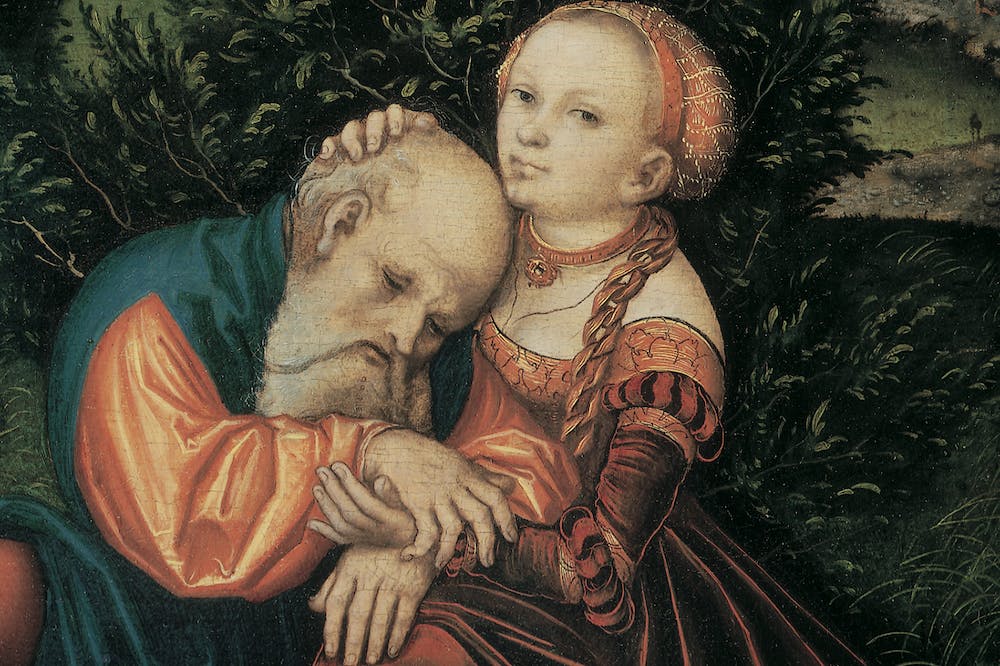
Lucas Cranach, Lot and His Daughters
Back to the Future
Whenever I think back on that day in Colchester with Anthony Gormley it is impossible not to feel grief at what we were so suddenly deprived of in March. In an attempt to correct this, I sometimes find myself groping a bit too obviously after positives.
When I speak to Sally Shaw, the director of First Site and a friend of the sculptor, she says, ‘I’m currently sitting in an empty gallery which is odd.’ It is another sad image.
But she tells me of an optimistic project she embarked upon during lockdown. It occurred to Shaw to start a series of Artist Activity Packs, and the first person she thought to contact was Gormley. ‘We thought it would be brilliant to get people to do something in their homes. I always remember colouring-in as a kid. We’d just done Field for the British Isles with Anthony and so I held my breath and wrote an email and asked him if he wanted to partner with us. Within ten minutes, I got a reply and we were doing it.’
The resulting project, in Shaw’s words, ‘went bonkers. We’ve done three packs and they’ve been distributed to 65,000 households. People were desperate to do something.’
There is something here which is more than just pie-in-the-sky consolation. During this time, the art world has shown tremendous resourcefulness, and an absolute commitment to the transformative power of art at this time.
When I was with Gormley before Field for the British Isles, I asked him how that piece would change if Scotland were to leave the Union. It was a question about the way in which art itself changes, as the world mutates.
On that occasion, Gormley dodged the question, answering that that would be the ‘next chapter in a long national story of unfolding madness.’
But a few months later, the B word has been replaced by the C-word, but looking over my transcripts I realise that not as much changes as we think it does.
At one point, Gormley says in his inimitably digressive way: ‘We’ve got to achieve social justice in a time when goods have absolute free passage globally, and yet somehow people do not. Why are we going backwards in time when we’ve been given all of the tools of the collective mind? The internet is the realisation of the idea of the biosphere circled by mind.’
A biosphere circled by mind’. It would be hard to think of a more apt or prescient description of the times we live in. It took an artist to say it, and it would take an artist to show it.
In Twickenham, it occurs to me that history is full of intended restorations and easy romanticisms which were thwarted in the end by the irreversible nature of time. For Gormley, Brexit was just the most recent of these. In reality we never restore past eras – and we shall not restore the world to March 17th 2020.
What hope might be placed in opposition to this? I find it in Turner’s House. Upstairs, where only three of us are allowed at a time, there’s a telescope which seeks to show the visitor what the view out of the artist’s bedroom would have been in his day. It is an image of an Arcadian landscape unimpinged-upon by the rows of samey semi-detached houses which we experience today. Marble House, occluded now, seemed right before the artist then. The river could be seen, and though you can’t see it now, the museum has rescued for us as an ingenious act of rescuing.
It strikes me that this project to understand the past shall continue, and in doing form our future. This endeavour shall include understanding better the past six months. To do that, you could do a lot worse than start with Lorna May Wadsworth’s exciting and original still lives. And it is a hopeful fact that at Turner’s House, though there is a bottle of hand sanitiser on the table next to it, visitors are still encouraged to touch that telescope.